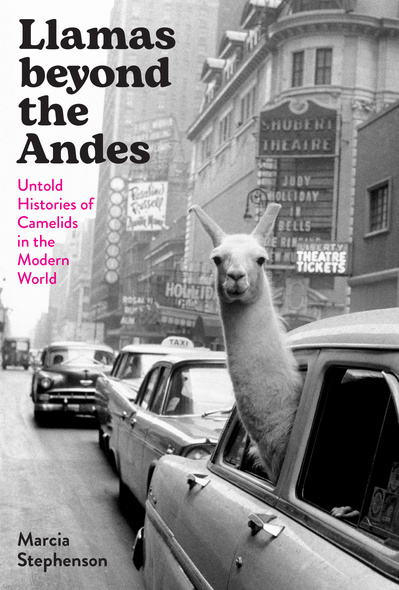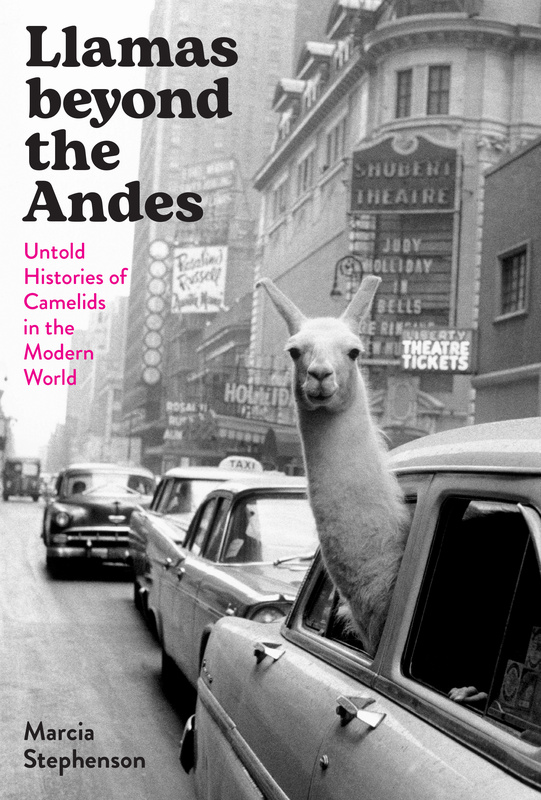
Llamas beyond the Andes
Untold Histories of Camelids in the Modern World
Camelids are vital to the cultures and economies of the Andes. The animals have also been at the heart of ecological and social catastrophe: Europeans overhunted wild vicuña and guanaco and imposed husbandry and breeding practices that decimated llama and alpaca flocks that had been successfully tended by Indigenous peoples for generations. Yet the colonial encounter with these animals was not limited to the New World. Llamas beyond the Andes tells the five-hundred-year history of animals removed from their native habitats and transported overseas.
Initially Europeans prized camelids for the bezoar stones found in their guts: boluses of ingested matter that were thought to have curative powers. Then the animals themselves were shipped abroad as exotica. As Europeans and US Americans came to recognize the economic value of camelids, new questions emerged: What would these novel sources of protein and fiber mean for the sheep industry? And how best to cultivate herds? Andeans had the expertise, but knowledge sharing was rarely easy. Marcia Stephenson explores the myriad scientific, commercial, and cultural interests that have attended camelids globally, making these animals a critical meeting point for diverse groups from the North and South.
This is a highly scholarly work, recommended for academic libraries with graduate programs in Latin American studies.
In this beautifully narrated and painstakingly researched history, Stephenson follows the tracks of the Andean camelid from Spanish colonial times in the high Andes, to Europe’s scientific laboratories, to the global marketplace in exotica and fibers through five centuries of Western imperial history. En route, it offers novel insights into the West’s predatory cultural contacts with Andean pastoral communities and the magnificent animals that sustained them.
This is a paradigm-shifting work with regard to the global histories of domestication, biotic exchange, and animal studies. It provides vivid, meticulously researched stories of the cultural ferment, the human drama, and the experiences of the animals themselves as these charismatic creatures reached new and unexpected shores with great difficulty.
In her brilliant new book, Marcia Stephenson goes beyond the fascination that Europeans showed for camelids as part of a New World exotica to pay attention to the symbolic meanings that these animals had within Andean culture, history, and religion, and how those meanings were transformed and appropriated once the animals were removed from their native habitats and circulated in other global contact zones. No other book offers such an informed examination, enabling us to understand the colonial legacies that permeated such projects. The interdisciplinary approach, well-chosen archival material, broad scope (geographically and temporarily), and outstanding analysis of the primary sources make this book a vital contribution.
Marcia Stephenson is an associate professor of Spanish at Purdue University. Her book Gender and Modernity in Andean Bolivia received the A. B. Thomas Award for Excellence.
- List of Abbreviations
- Introduction. “The Most Interesting Animals in the World”: Reconstructing Histories of Andean Camelids in Transoceanic Contact Zones
- Chapter 1. From Marvelous Antidote to the Poison of Idolatry: The Transatlantic Significance of Andean Bezoar Stones during the Late Sixteenth and Early Seventeenth Centuries
- Chapter 2. Exploring the Body-Interior: Autopsy in Colonial Camelid Contact Zones
- Chapter 3. From Curiosity to Commodity: Early Efforts to Ship Living Camelids to Europe
- Chapter 4. The Science of Acclimatization: Llamas and Alpacas in Nineteenth-Century France
- Chapter 5. Andean Itineraries of Nineteenth-Century Camelid Science: The Case of Charles Ledger
- Chapter 6. Camelids in Australia: The Rise and Fall of Charles Ledger’s Alpaca Ambitions
- Chapter 7. US Camelid Contact Zones in the Twentieth Century: Authenticity, Exoticism, and Celebrity
- Conclusion. The Afterlives of Camelid Contact Zones
- Acknowledgments
- Notes
- Works Cited
- Index




